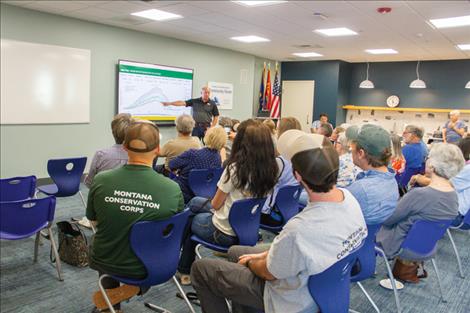Lake reaches full pool, lower water levels expected during summer months
Hey savvy news reader! Thanks for choosing local.
You are now reading
2 of 3 free articles.
Flathead Lake is currently full but unlikely to stay that way as predicted hot, dry summer conditions take hold in July. Brian Lipscomb, CEO of Energy Keepers Inc., anticipates that the lake’s water level will sag by a foot or possibly more next month. When inflows drop below minimum outflows, the lake level drops he said.
EKI, which is licensed to manage the top ten feet of water on Flathead Lake in its energy production at Séliš Ksanka QÍispé Dam, came under scrutiny last summer when the lake’s water levels dipped to record lows - 30 inches below full pool at its lowest point. EKI responded by shifting to the lowest minimum outflows required by their license. Following accusations of mismanagement, the Federal Energy Regulatory Commission determined via investigation that EKI complied with the operational requirements of their license during the summer of 2023.
To share current state of the lake information and let residents know what they can expect this summer, Lipscomb took the opportunity to speak at a recent meeting of the Lake County Democrats. To the nearly 50 people gathered in the North Lake County Public Library conference room, he explained that water supply is at the heart of the issue.
“June, July and August of 2023 were some of the lowest water supplies we’ve ever experienced in the Flathead,” Lipscomb said.
Rising average global surface temperatures is what’s driving the change, he added, noting that 2023 was the hottest year on record globally.
“These small changes in averages bring big changes in extremes,” he said. While 2023 saw record low lake levels, Lipscomb reminded meeting attendees that the lake overfilled by 7 inches the previous year, in 2022. He noted that the only other year the lake overfilled since the dam was built was in 1964.
Big swings in water supply – from too much to too little – are becoming more common. According to the National Oceanic and Atmospheric Administration, El Niño and La Niña are “opposing climate patterns in the Pacific Ocean that can affect weather worldwide.” El Niño brings warmer, drier winter weather patterns to the Pacific Northwest, ultimately impacting water supplies through less snowfall. La Niña patterns bring cooler than normal winter temperatures, heavy rains and flooding in the Pacific Northwest. According to the NOAA website, while these episodes occur on average every two to seven years, there is no regular schedule and El Niño generally occurs more frequently than La Niña.
Lipscomb noted that we’re just finishing an El Niño winter cycle. “The good news is this is starting to transition,” he said. “There’s a 60% chance that by the end of summer we’ll be in a La Niña winter cycle. We’re hot and dry now and have been for two years.”
Lipscomb noted that energy demands are also increasing as it takes more electricity to cool people’s homes during extreme heat waves. “Those heat cycles that we see in the summer time are going to get worse – they’re not going to get better,” he said. “The best I can do is keep people informed.”
To that end, EKI has developed a Range of Forecast graphic that shows a range for predicted water levels on Flathead Lake during the summer months. The graphic plots actual inflow and outflow data and corresponding water levels on the left side with forecasted inflows and corresponding high and low water levels on the right. The Range of Forecast graphic is updated weekly and posted to EKI’s website and Facebook page.

















